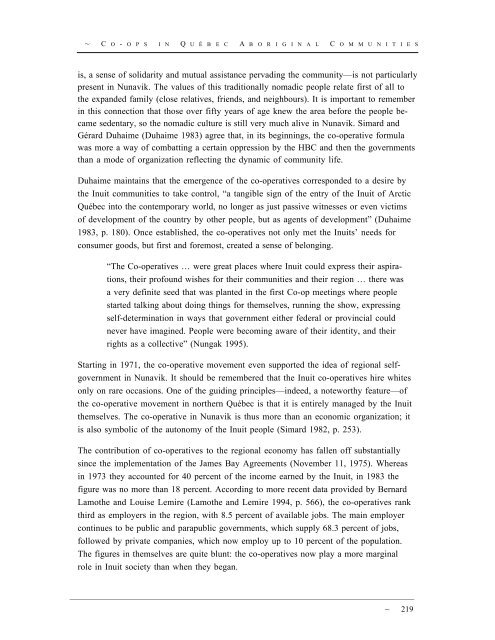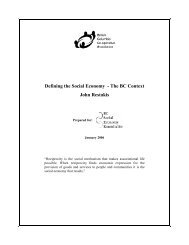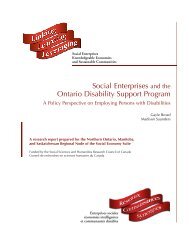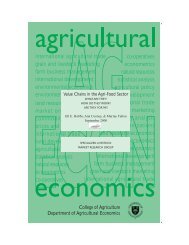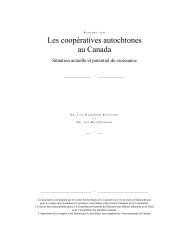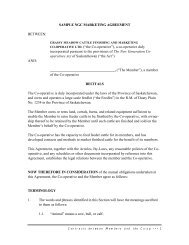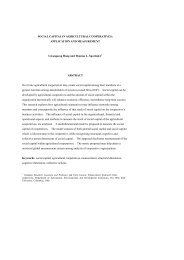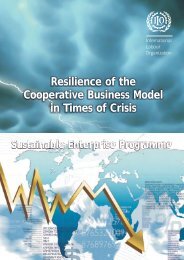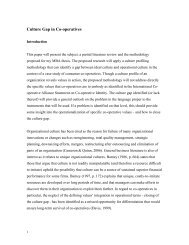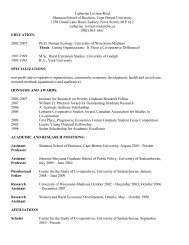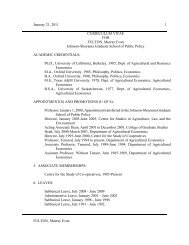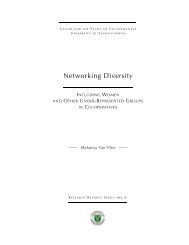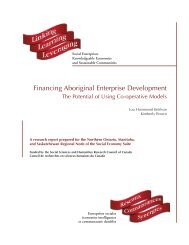Aboriginal Co-operatives in Canada - Centre for the Study of Co ...
Aboriginal Co-operatives in Canada - Centre for the Study of Co ...
Aboriginal Co-operatives in Canada - Centre for the Study of Co ...
You also want an ePaper? Increase the reach of your titles
YUMPU automatically turns print PDFs into web optimized ePapers that Google loves.
~ C O - O P S I N Q U É B E C A B O R I G I N A L C O M M U N I T I E Sis, a sense <strong>of</strong> solidarity and mutual assistance pervad<strong>in</strong>g <strong>the</strong> community—is not particularlypresent <strong>in</strong> Nunavik. The values <strong>of</strong> this traditionally nomadic people relate first <strong>of</strong> all to<strong>the</strong> expanded family (close relatives, friends, and neighbours). It is important to remember<strong>in</strong> this connection that those over fifty years <strong>of</strong> age knew <strong>the</strong> area be<strong>for</strong>e <strong>the</strong> people becamesedentary, so <strong>the</strong> nomadic culture is still very much alive <strong>in</strong> Nunavik. Simard andGérard Duhaime (Duhaime 1983) agree that, <strong>in</strong> its beg<strong>in</strong>n<strong>in</strong>gs, <strong>the</strong> co-operative <strong>for</strong>mulawas more a way <strong>of</strong> combatt<strong>in</strong>g a certa<strong>in</strong> oppression by <strong>the</strong> HBC and <strong>the</strong>n <strong>the</strong> governmentsthan a mode <strong>of</strong> organization reflect<strong>in</strong>g <strong>the</strong> dynamic <strong>of</strong> community life.Duhaime ma<strong>in</strong>ta<strong>in</strong>s that <strong>the</strong> emergence <strong>of</strong> <strong>the</strong> co-<strong>operatives</strong> corresponded to a desire by<strong>the</strong> Inuit communities to take control, “a tangible sign <strong>of</strong> <strong>the</strong> entry <strong>of</strong> <strong>the</strong> Inuit <strong>of</strong> ArcticQuébec <strong>in</strong>to <strong>the</strong> contemporary world, no longer as just passive witnesses or even victims<strong>of</strong> development <strong>of</strong> <strong>the</strong> country by o<strong>the</strong>r people, but as agents <strong>of</strong> development” (Duhaime1983, p. 180). Once established, <strong>the</strong> co-<strong>operatives</strong> not only met <strong>the</strong> Inuits’ needs <strong>for</strong>consumer goods, but first and <strong>for</strong>emost, created a sense <strong>of</strong> belong<strong>in</strong>g.“The <strong>Co</strong>-<strong>operatives</strong> … were great places where Inuit could express <strong>the</strong>ir aspirations,<strong>the</strong>ir pr<strong>of</strong>ound wishes <strong>for</strong> <strong>the</strong>ir communities and <strong>the</strong>ir region … <strong>the</strong>re wasa very def<strong>in</strong>ite seed that was planted <strong>in</strong> <strong>the</strong> first <strong>Co</strong>-op meet<strong>in</strong>gs where peoplestarted talk<strong>in</strong>g about do<strong>in</strong>g th<strong>in</strong>gs <strong>for</strong> <strong>the</strong>mselves, runn<strong>in</strong>g <strong>the</strong> show, express<strong>in</strong>gself-determ<strong>in</strong>ation <strong>in</strong> ways that government ei<strong>the</strong>r federal or prov<strong>in</strong>cial couldnever have imag<strong>in</strong>ed. People were becom<strong>in</strong>g aware <strong>of</strong> <strong>the</strong>ir identity, and <strong>the</strong>irrights as a collective” (Nungak 1995).Start<strong>in</strong>g <strong>in</strong> 1971, <strong>the</strong> co-operative movement even supported <strong>the</strong> idea <strong>of</strong> regional selfgovernment<strong>in</strong> Nunavik. It should be remembered that <strong>the</strong> Inuit co-<strong>operatives</strong> hire whitesonly on rare occasions. One <strong>of</strong> <strong>the</strong> guid<strong>in</strong>g pr<strong>in</strong>ciples—<strong>in</strong>deed, a noteworthy feature—<strong>of</strong><strong>the</strong> co-operative movement <strong>in</strong> nor<strong>the</strong>rn Québec is that it is entirely managed by <strong>the</strong> Inuit<strong>the</strong>mselves. The co-operative <strong>in</strong> Nunavik is thus more than an economic organization; itis also symbolic <strong>of</strong> <strong>the</strong> autonomy <strong>of</strong> <strong>the</strong> Inuit people (Simard 1982, p. 253).The contribution <strong>of</strong> co-<strong>operatives</strong> to <strong>the</strong> regional economy has fallen <strong>of</strong>f substantiallys<strong>in</strong>ce <strong>the</strong> implementation <strong>of</strong> <strong>the</strong> James Bay Agreements (November 11, 1975). Whereas<strong>in</strong> 1973 <strong>the</strong>y accounted <strong>for</strong> 40 percent <strong>of</strong> <strong>the</strong> <strong>in</strong>come earned by <strong>the</strong> Inuit, <strong>in</strong> 1983 <strong>the</strong>figure was no more than 18 percent. Accord<strong>in</strong>g to more recent data provided by BernardLamo<strong>the</strong> and Louise Lemire (Lamo<strong>the</strong> and Lemire 1994, p. 566), <strong>the</strong> co-<strong>operatives</strong> rankthird as employers <strong>in</strong> <strong>the</strong> region, with 8.5 percent <strong>of</strong> available jobs. The ma<strong>in</strong> employercont<strong>in</strong>ues to be public and parapublic governments, which supply 68.3 percent <strong>of</strong> jobs,followed by private companies, which now employ up to 10 percent <strong>of</strong> <strong>the</strong> population.The figures <strong>in</strong> <strong>the</strong>mselves are quite blunt: <strong>the</strong> co-<strong>operatives</strong> now play a more marg<strong>in</strong>alrole <strong>in</strong> Inuit society than when <strong>the</strong>y began.~ 219


